Journal •
Field Notes: On proximity and process with residents

Two Dublin public housing estates – one demolished and regenerated, one ageing but intact – are revealing the same challenge: community agency has shrunk and is slow to emerge. Blue Drum, a community arts organisation, has been addressing this challenge through field work in two locations. The first is with Charlemont Street Community Resource Centre in a new regenerated public housing complex in Dublin’s south inner city, and the second is a community in 1970s public housing in Loughlinstown, Dún Laoghaire-Rathdown.
Both estates share a history that can be tracked back to Ireland’s post 1940s response to acute housing need. Writer Paul Howard captures the impulse upon arrival to a new house in those days from a childhood memory: “We got the 45A bus to Ballybrack to see the house. It was ah, I mean you could spend your whole life trying to get that feeling again of just excitement and newness, and you’d chase that for your whole life and never feel it but I felt it as a kid.”
A new social housing complex in Charlemont arose from the obsolescence of two public housing sites: the 1944 ffrench Mullen House (designed by Michael Scott) and the adjacent 1969 Tom Kelly flats. Loughlinstown was designed by Herbert K. Unger, Dún Laoghaire-Rathdown’s architect, who emigrated from Nazi Germany to Ireland in 1938. Klaus Unger, Herbert Unger’s son, recently told residents during a walkabout how he found these estates ‘amazing’: houses designed organically to human scale, with rear vehicle access while front entrances open onto gardens that transition seamlessly into shared green islands with footpaths, laneways, and trails.
Through Blue Drum’s cross-community analysis a common theme emerges. A decade after regeneration commenced in Charlemont, the housing is better but community life is thinner: original residents appreciate the improved physical quality but report less social interaction. In Loughlinstown, almost fifty years after its development, the gardens, the mapping, the photography, the memory work reveal patterns, relationships, and knowledge that institutional processes overlooked. These creative practices generate curiosity about what has been there, what’s already there and what residents might want for their children and grandchildren. Mobilising residents to define and pursue their future is the shared challenge.
In both Loughlinstown and Charlemont, local civil society—schools, community groups, heritage and arts organisations—can play a distinct role that public institutions and partnerships cannot. Community culture and heritage work makes visible what institutional processes overlook, disregard or can’t measure. Yet these restorative processes unfold beneath the slower rhythms of institutional decision-making. Both these parallel experiences opened an alternative pathway where community agency operates independently of institutional timelines.
In Charlemont, Blue Drum and the Charlemont Community Resource Centre proposed a design process for an outdoor podium deck that formed part of the new development, to be used as a community-managed, programmable space. Working with residents and staff, they established a vision for the Deck as a green culture garden. For just over a year, residents workshopped uses for the deck. In January 2025, a small group of adults and children began weekly gardening sessions with arts practitioners.
Fiachra O’Mathúna, coordinator of Charlemont Community Resource Centre, said: “The Green Culture Garden concept and workshops have seeded real community building. We don’t know what will grow, but it’s seeded and we look forward to seeing it develop.” The culture garden made the Irish Times ‘best green community’ shortlist in July 2025.
In Loughlinstown, a similar pathway to community agency emerged through community-led mapping of memories, nature and activities. After Arts Council support for a Southside Partnership research initiative, Creative Places, ended in early 2024, residents and leaders from the Women’s Collective Ireland and the estate management structures continued working with Blue Drum on their own initiative and timeline. Despite not securing funding, residents worked to map their Linear Park environment across memory, activity, and nature. Denis Murray, an environmentalist, noted: “The mapping process has really helped focus and reinvigorate resident action.” The mapping gained traction at the institutional level in ways the earlier institutional funded research initiative had not. This momentum led to ‘Heritage and Arts in the Community: Towards Loughlinstown at 50 years – 2028’, bringing together 100 people with partners to celebrate the estate’s past and begin shaping plans for its 50th anniversary. These actions in Loughlinstown would not have materialised had the residents awaited formal institutional frameworks. The mapping demonstrated how community-led initiatives can emerge organically when residents, even in small numbers, choose to act independently of approval processes. This represents a fundamental shift from waiting to doing, which proves essential for sustainable community development.
Both experiences, in Loughlinstown and Charlemont, reveal that community expertise and action, and institutional capacity and initiative, operate at different rhythms. The challenge is not to eliminate this difference, but to use community-led timing and action as a tactic to gradually shift and capture institutional attention and resources. The question is no longer whether communities can lead, but whether champions from institutions have the wisdom to follow.
Journal Article by Blue Drum’s Ed Carroll and Vita Gelūnienė. Photography by Darius Petrulis as part of the exhibition Who is My Neighbour for Open House 2025.












